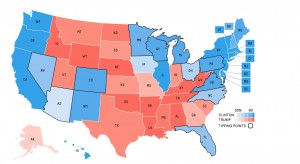
It is pretty clear that technology has played an important part in elections in this country, ranging from the first JFK-Nixon debate and how a televised debate led the viewers to a different conclusion than those who listened to it on radio. Dial forward and we all witnessed the power of the social media and data analytics starting from the 2008 election.
In this election technology has been a huge influencer on how things are beginning to unravel. The Trump videos from 2005 (Warning: Graphic Language!) show the dangers of digital media. Once recorded, digital content generally has a long shelf life. Especially if the content is about celebrities or of historic significance etc. Increasingly, thanks to free or cheap storage from cloud service providers such as Google, Microsoft and Dropbox, even we all tend to save everything at our disposal. Many do not understand the long term implication of all of this – their safety, who has access to them, how deleting them in one place doesn’t really delete them everywhere etc.
Then you have WikiLeaks releasing alleged emails from Hillary Clinton’s campaign as well as her speeches to wall street companies. Whereas leaking documents and letters applies equally to paper as it does to born digital content in that someone with access can leak it to other parties easily or they can be both be stolen. However, we can all agree that it is easier to “steal” them in the electronic realm because one doesn’t have to be physically present to commit such an act.
Both of these are cases where lessons are to be learned – be very careful about what you say because it is here to stay for the long haul; what you said for the first time matters a lot; and almost all of what you said will be taken out of context by some group or the other!
But there are some exciting application of technologies in the middle of all of these chaos. From what we have been able to gather, Hillary’s campaign seems to be using the data to target return on investment whether it is deciding where to spend the money on TV ads, where she should speak next or where should the ground troops be knocking on the doors for the votes. It does not appear that Trump’s campaign seems to have a strategy regarding the use of the data effectively.
Online voter registration was first adopted by Arizona in 2002, but in the recent past, many other states have joined and about 38 states now offer them. Some even make it easy to do from a mobile phone.
Pew Charitable Trust in collaboration with Google and various states has launched Voting Information Project (VIP), which “helps voters find information about their elections with collaborative, open-source tools.” Another win for open source tools! The underlying tool that makes it work is Google’s Civic Information API (Application Programming Interface). Get to the Polls is an application in VIP that can be used to find your polling location, the hours it is open etc.
Of course, the social media is already going crazy and will light up with variations of “I voted, did you?” on election day. It will also probably be used to let the voters know about how busy polling stations are. This is something that cannot be relied on because there have been instances of misleading voters to discourage them from voting! Hope Wellesley’s Takis Metaxas’s Twittertrails will help decide the truth.
Electronic voting is another topic that comes up all the time and you can read about them and the associated security flaws here. As the article points out, this is not commonplace and also is not electronic alone. Given how the global interest in deciding our election is playing out (such as the WikiLeaks), unless the security concerns are fully addressed, this will remain (for all the right reasons) one of the last things that will go fully electronic.
I can go on, but I want to stop with one last thing. Election forecasts. They are fascinating and I am addicted to following Realclearpolitics and Fivethirtyeight. The analysis, the presentation and clarity of information are all superb. One of the things that fascinates me is how the polls still rely heavily on the science of sampling, despite the easy availability big data! Here is an example where you can see the sample size. You will see that with the exception of Google Consumer Surveys, all the samples are less than 3000 voters. The power of sampling continues to amaze me and I suggest that you read “Big Data: are we making a Big Mistake?” which talks about the “traps that lie in wait” in data analysis and how big data doesn’t necessarily solve this. Looks like successful polling companies are sticking to nano-data for now.
Finally, what we need is a reliable app that shows the congestion level at a polling station. This could be based on the detection of bluetooth devices (like highways do now) or Google tools detecting geolocation of devices and adjusting for various factors to provide a reasonably reliable estimate. Or, using the VIP tool described above, the state employees at the polling stations pressing a button to indicate Light, Moderate or Long Wait times which is updated every 5 minutes.
Now, why should I be worrying about this? I live in a town of 8000 residents in CT where I vote and the lines are not that long ever and we even have time for a friendly chat with the volunteers before voting!